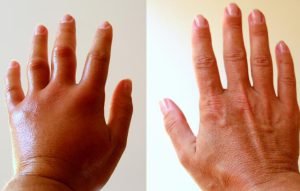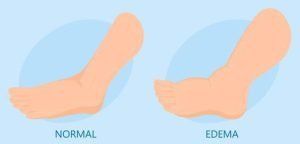Edema is a medical condition characterized by fluid accumulation in the body’s tissues, causing swelling and discomfort. It is a common problem that can occur for various reasons, affecting people of all ages and genders. The swelling can be mild or severe and occur in any part of the body.
In this article, we will discuss the causes, symptoms, and treatment options for edema.

Causes of Edema:
There are many causes of edema, including:
- Heart Failure: its occurs when the heart cannot pump blood efficiently, causing fluid to accumulate in the lungs . And other parts of the body.
- Kidney Disease: Kidney disease can lead to fluid retention in the body, as the kidneys cannot filter the blood adequately.
- Liver Disease: Liver disease can also cause fluid retention due to decreased protein production, which leads to a reduction in osmotic pressure in the blood vessels.
- Pregnancy: Pregnant women may experience edema due to increased pressure on the blood vessels and hormonal changes in the body.
- Medications: Certain medications, such as nonsteroidal anti-inflammatory drugs (NSAIDs), calcium channel blockers, and steroids, can cause edema as a side effect.
- Injuries: Edema can occur due to an injury, such as a sprain, fracture, or blunt force trauma. The swelling is the body’s response to the injury, and it usually goes away on its own within a few days or weeks.
Symptoms of Edema:
The symptoms of edema depend on the severity of the condition and the location of the swelling. Some common symptoms include:
- Swelling: Swelling is the most common symptom of edema. It can occur in any part of the body, but it is most common in the feet, ankles, and legs.
- Stiffness: Stiffness in the affected area may also occur, making it difficult to move the joint or limb.
- Weight Gain: If the edema is severe, it can cause weight gain due to increased fluid retention.
- Pitting: When you press your finger against the affected area, it may leave a pit or indentation that takes a few seconds to disappear.
- Shortness of Breath: If edema is caused by heart or lung disease, it may lead to shortness of breath.

Treatment options for Edema:
Here are some common treatment options:
- Diuretics: Diuretics are medications that help the body eliminate excess fluids through urine. They are commonly used to treat edema caused by heart or kidney disease.
- Compression Stockings: Compression stockings are specially designed stockings that apply pressure to the legs, helping to reduce swelling.
- Elevating the Affected Area: Elevating the affected area above the heart can help reduce swelling by allowing the excess fluid to drain back into the circulatory system.
- Lifestyle Changes: Lifestyle changes, such as reducing salt intake, maintaining a healthy weight, and getting regular exercise, can help prevent edema from occurring.
- Surgery: In severe cases, surgery may be necessary to remove excess fluid from the affected area.

Preventing Edema:
There are several steps you can take to prevent edema from occurring, including:
- Maintaining a Healthy Weight: Being overweight can increase the risk of developing edema, so it’s important to maintain a healthy weight through a balanced diet and regular exercise.
- Reducing Salt Intake: Consuming too much salt can cause the body to retain fluid, so it’s important to limit salt intake.
- Staying Active: Regular exercise can help improve circulation and prevent fluid buildup in the legs and feet.
- Avoiding Prolonged Sitting or Standing: If you sit or stand for prolonged periods, try to take breaks and move around to prevent fluid buildup in the legs.
Edema is a common medical condition that can affect people of all ages and genders. While it may not always be preventable, there are steps you can take to reduce your risk of developing it. If you are experiencing swelling or other symptoms of edema, it is important to talk to your healthcare provider to determine the underlying cause and receive appropriate treatment. With the right treatment and self-care measures.




